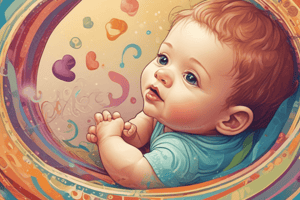Podcast
Questions and Answers
At what age range does the prenatal period and infancy occur?
At what age range does the prenatal period and infancy occur?
- 2~3 - 11 years
- 12 - 25 years
- Conception - 2~3 years (correct)
- Birth - 2 years
Which of the following is an example of continuity in human development?
Which of the following is an example of continuity in human development?
- Development of language skills
- Ability to walk
- Personality traits (correct)
- Emotional discomfort
What is a crucial aspect of early experience during infancy that significantly impacts development?
What is a crucial aspect of early experience during infancy that significantly impacts development?
- Social media interaction
- Reading skills
- Physical education
- Language exposure (correct)
Which period of human development follows infancy?
Which period of human development follows infancy?
What occurs during the embryonic stage of prenatal development?
What occurs during the embryonic stage of prenatal development?
What is one common misconception about early memories in infants?
What is one common misconception about early memories in infants?
What sensory experience can infants detect while in utero?
What sensory experience can infants detect while in utero?
What factor can contribute to individual differences across the human population during infancy?
What factor can contribute to individual differences across the human population during infancy?
At what stage of pregnancy are important organs being developed?
At what stage of pregnancy are important organs being developed?
How many hours does the average newborn typically sleep in a 24-hour period?
How many hours does the average newborn typically sleep in a 24-hour period?
Which type of crying signalizes a baby's need for something?
Which type of crying signalizes a baby's need for something?
What is the primary method used to gauge infants' perception toward stimuli?
What is the primary method used to gauge infants' perception toward stimuli?
At what point in life does visual acuity in infants reach approximately 20/120?
At what point in life does visual acuity in infants reach approximately 20/120?
Which of the following reflexes is NOT an example of a reflex that lasts for a person's entire lifespan?
Which of the following reflexes is NOT an example of a reflex that lasts for a person's entire lifespan?
When does color perception and depth perception begin to develop in infants?
When does color perception and depth perception begin to develop in infants?
Which of the following statements about infant motor skills is true?
Which of the following statements about infant motor skills is true?
What is the sequence of processes that occurs in brain development from neurogenesis to synaptic pruning?
What is the sequence of processes that occurs in brain development from neurogenesis to synaptic pruning?
What impact do teratogens have on fetal development?
What impact do teratogens have on fetal development?
At what stage of prenatal development does the fetus begin to hear outside sounds?
At what stage of prenatal development does the fetus begin to hear outside sounds?
What happens during synaptic pruning?
What happens during synaptic pruning?
How do fetuses respond to external auditory stimuli?
How do fetuses respond to external auditory stimuli?
Which of the following substances is classified as a teratogen?
Which of the following substances is classified as a teratogen?
What is the difference between critical and sensitive periods in fetal development?
What is the difference between critical and sensitive periods in fetal development?
In what scenario would a developing baby be more likely to recognize auditory stimuli such as music or speech?
In what scenario would a developing baby be more likely to recognize auditory stimuli such as music or speech?
Flashcards
Human Development
Human Development
The study of how humans change and stay the same throughout their lives.
Continuity in Development
Continuity in Development
Characteristics that remain consistent over time.
Change in Development
Change in Development
Changes that happen in a person's life.
Prenatal and Infancy
Prenatal and Infancy
Signup and view all the flashcards
Childhood
Childhood
Signup and view all the flashcards
Adolescence
Adolescence
Signup and view all the flashcards
Adulthood
Adulthood
Signup and view all the flashcards
Prenatal Development
Prenatal Development
Signup and view all the flashcards
Neurogenesis
Neurogenesis
Signup and view all the flashcards
Myelination
Myelination
Signup and view all the flashcards
Synaptogenesis
Synaptogenesis
Signup and view all the flashcards
Synaptic pruning
Synaptic pruning
Signup and view all the flashcards
Teratogens
Teratogens
Signup and view all the flashcards
Critical Period
Critical Period
Signup and view all the flashcards
Sensitive Period
Sensitive Period
Signup and view all the flashcards
Fetal Experience
Fetal Experience
Signup and view all the flashcards
Embryonic stage
Embryonic stage
Signup and view all the flashcards
REM sleep
REM sleep
Signup and view all the flashcards
Non-REM sleep
Non-REM sleep
Signup and view all the flashcards
Visual acuity
Visual acuity
Signup and view all the flashcards
Color perception
Color perception
Signup and view all the flashcards
Depth perception
Depth perception
Signup and view all the flashcards
Reflexes
Reflexes
Signup and view all the flashcards
Study Notes
Prenatal and Infant Development
-
Human development examines continuity and change throughout life.
-
Developmental psychologists often study younger children, as changes are significant during this period.
-
Continuity refers to consistent aspects of human nature, like personality.
-
Change can be gradual or abrupt, like learning to walk.
-
Development encompasses sensation & perception (sensing and interpreting surroundings), cognition and language (thinking and communication), emotion (controlling and expressing feelings), and social/moral behavior (appropriate social interactions).
-
Human development encompasses four major periods:
- Prenatal period and infancy (conception to ~2-3 years)
- Childhood (2-3 to 11 years)
- Adolescence (12 to ~25 years - when brain maturation stops)
- Adulthood(~25 years - death)
-
Note: These ages are approximate as individuals develop on different timelines.
Warm-Up Exercise
- Most frequent earliest memories form between 3 and 4 years old.
- Early memories are often vague or non-existent, or they may be related to a strong emotional experience or high sensory input.
Early Experience in Infancy
-
Experiencing the world in infancy influences development greatly, affecting language, food preferences, and other learned behaviors.
-
In-utero experiences influence development.
- Prenatal sounds, including mother's speech rhythm
- Tactile sensations of the mother's movement
- Tastes and smells in the womb, (e.g., preference for mother's food).
Prenatal Development
- Prenatal development occurs in three stages
- Germinal stage (0-3 weeks): begins with conception, characterized by the zygote. Following implantation, the germinal stage ends.
- Embryonic stage (3-8 weeks): a period of organ development.
- Fetal stage (9 weeks to birth): focused on growth and maturation of bodily systems.
Developmental Process in Brain Development
- Neurogenesis: creation of neurons
- Myelination: refining neurons for smoother transmission
- Synaptogenesis: the creation of connections between neurons.
- Synaptic pruning: trimming of unused connections to make pathways more efficient.
Fetal Experience and Sensation
- The womb isn't wholly silent; fetuses can experience sounds and other stimuli.
- Fetal heartbeat responses change in reaction to external stimuli.
- Fetuses can recognize their mothers' voices and language.
Teratogens
- External factors can disrupt fetal development, including alcohol, drugs, and viruses.
- Critical and sensitive periods are times of intense development where exposure to teratogens can have significant effects.
Newborns and Beyond
- Infants primarily sleep, to facilitate development of their physical and cognitive skills
- Sleep amounts differ among new-borns.
Neonatal Sleep
- Sleep patterns change across different ages, with newborns requiring significantly more sleep than adults.
- Visual cues (visual acuity) and auditory (evoked responses), develop throughout early childhood.
Perceptual Development
- Sensation involves detecting physical stimuli; perception involves interpreting those signals.
Measuring Infant Perception
- Preferential looking tests observe infants' visual responses to different stimuli.
- Infants show visual preferences for stimuli their brains recognize as pleasing and familiar.
Motor Development
- Motor skills, like reflexes, develop alongside perceptual skills.
Studying That Suits You
Use AI to generate personalized quizzes and flashcards to suit your learning preferences.



